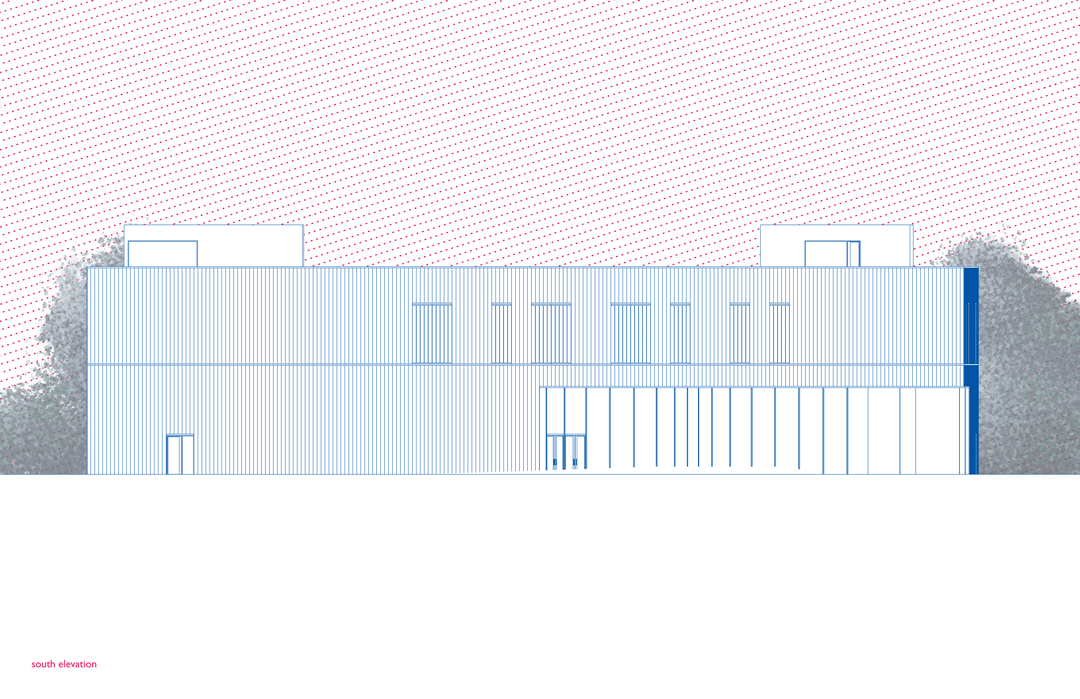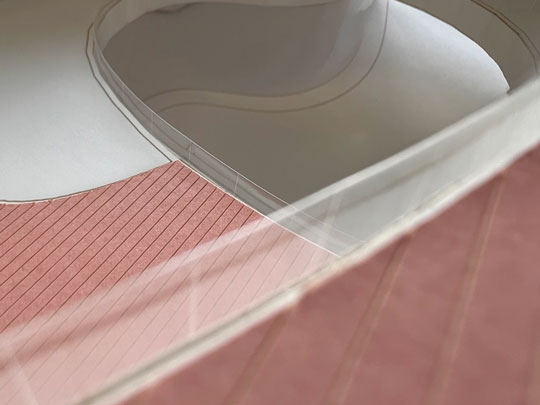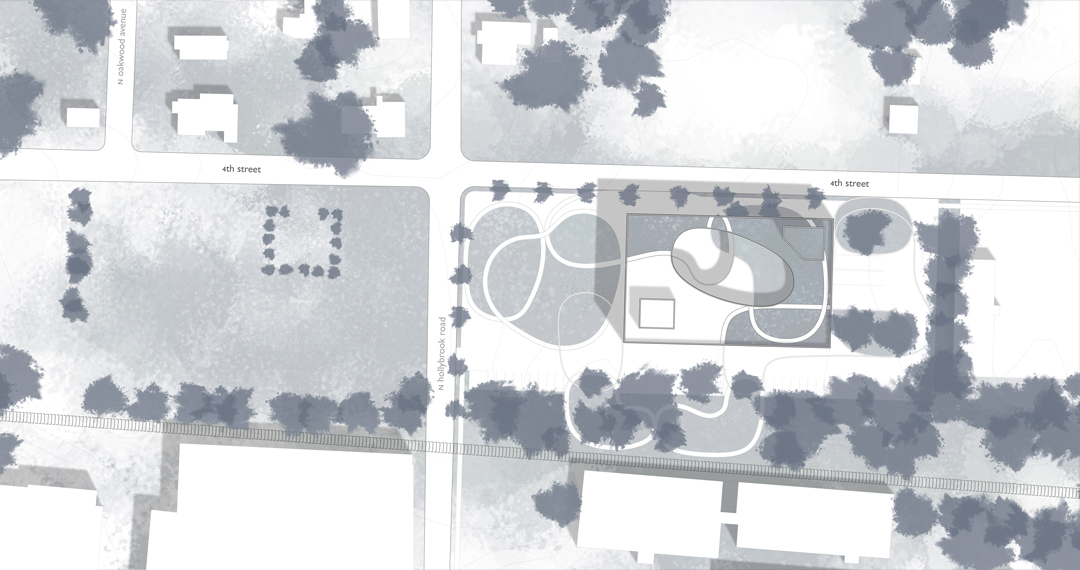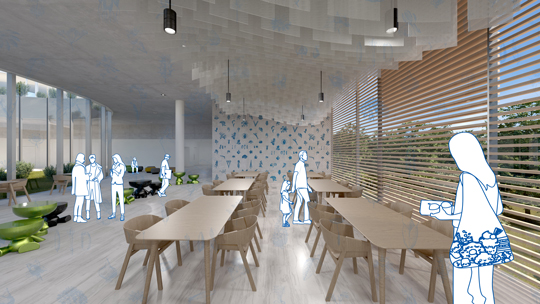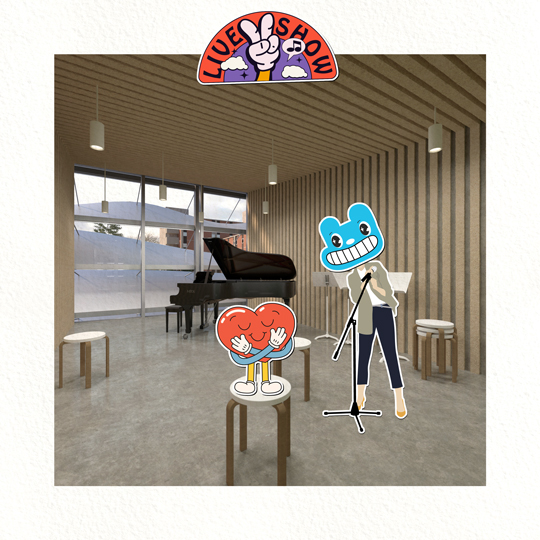First-Year Engineering + Esports Arena
2025 03-08
Mann Hall
Raleigh, NC USA
The renovation of this 1962 building is mostly interior with all the existing walls demolished for new classrooms, facilities, student affairs, staff suites, and an esports arena. What used to be a series of completely isolated floors has become one cohesive space because of the central stair that connects disparate programmatic elements together. This new lobby invites students and faculty to discover and engage with one another, acting as both the navigation system and the destination. To the exterior shell, careful interventions in specific places like adding the patios at key entrances are implemented to soften the thresholds with social activities and greenery. Every decision and every detail respects the building's original conditions without reproducing any dated designs. Mann Hall is already a recognizable symbol on campus with its rhythmic facade and gravitas, so the design must instead focus on maximizing its function and efficiency to meet contemporary standards of accessibility, inclusivity, and sustainability.
Community Center
2023 01-18 — 04-23
Food Justice Center
Wendell, NC USA
To address food apartheid in Wendell, the project reserves land for marginalized communities and local start-ups to directly source, farm, process, and distribute food, free from the system that oppresses them. So, the program naturally follows these stages of production, but the design is not interested in their rigid order. Instead, everything is woven together with a series of overlapping loops that defines farming spaces with accessible routes, creates visual breaks to slow down traffic, carves entrances to the building, and opens a courtyard for natural lighting and social gatherings. For partners and members of the Food Justice Center, the organic spatial quality accommodates diverse uses, and for patrons and visitors, it encourages discovery and participation. However, the need for this center has nothing to do with architecture, the same way food apartheid is not really about food. In fact, the planet has enough to feed every person alive. Yet, access is limited by the socio-economic conditions governing certain places. The design increases connectivity in Wendell, reduces costs by maximizing efficiency, formulates a culturally sensitive program, and implements sustainable strategies to disrupt the conventional supply chain. Still, it cannot change racist policies that deny people even the most basic living need, food. Architecture does not have the answer to sovereignty; at best, it serves as a backdrop for people who actually have to fight for change.
University Music Department
2022 10-28 — 12-02
Broughton Hall
Raleigh, NC USA
With a student center connecting directly through a pedestrian bridge on the east and the library not far to the north, this site becomes an important intersection on campus. There is potential to establish a new landmark and provide space for social and civic activities in a way that adds new meaning to life at NC State University. So, the design prioritizes the surrounding landscape as much as the building itself, maximizing access for the public well beyond its closing time. By taking advantage of the dramatic natural slope to create an outdoor theater, the project plays with the cultural memory of grand entrances and showmanship, and the generous, circular opening above effectively incorporates this space with the interior where students build their talents and refine their skills in music. Every detail celebrates the fluid and harmonic rhythm of music, from the control joints of the gypsum soffit to the iconic curving fins around the curtain walls that respond to views and daylighting as well. Nothing else on campus can reflect light the same way this aluminum facade does, just like a spotlight illuminating the performer.
Fire Department + Community Center
2021 09-08 — 12-03
Station 9
Atkinson, NC USA
In dealing with the interconnected issues of low-income individuals in Pender County, a holistic approach is required to provide relief for mental health issues, food insecurity, placelessness, hurricane impacts, and internet access in conjunction with all the assistance from existing fire stations and healthcare facilities. Specifically, in Atkinson, the community center will operate as an extension to Station 9 and Black River Health Services with adaptable spaces and activities for disaster response. However, rather than having a separate facility, the community center is integrated with the fire department to take advantage of the smaller footprint, offer disports for firefighters, and keep residents in touch with the first responders. Unlike conventional fire stations that alienate pedestrians with large concrete driveways, Station 9 achieves the same kind of efficiency with a much more friendly front yard by turning the truck bays to the alleyway and effectively adding space for a more convenient maneuver away from the busy street. This strategy also turns the building around to interlock it with the exposed structural grid that has been extended to become a framework for installations such as canopies, pergolas, and an agrivoltaic system, for instance. The same grid gradually transitions people inside where exterior shutters provide full control of the sunlight and views under deep roof cones that hide and lift mechanical systems off the ground and away from potential floods. Free of columns that have been carried to the outside, the expansive interior is completed with movable, modular furniture and partitions to accommodate the changing needs of a thriving community as verified by the stakeholders.
Social Center
2021 03-01 — 04-29
Roney & Hunt Social Center
Durham, NC USA
Sitting beside Durham Central Park at one of the liveliest intersections between people, culture, art, and nature, the project builds upon the memories of a 1930s steel fabrication shop to create a new kind of industrial building that forges community life. Likewise, the design language rationalizes the difference, or rather similarities, between a park and a factory by incorporating ways to relate the large scale of plants and machines to humans, space out the activities along winding paths while bringing the sunlight inside for various functions depending on the program elements. At the center of everything is a courtyard puncturing through the entire building to accommodate large trees and seamlessly transition visitors from outside in. to further enhance this central experience, a lighting system is developed to visually open up the courtyard to the sky and illuminate adjacent spaces without causing unnecessary glare. Modular shelving walls that bring down such expansive interior also provide maximum flexibilities for users to control the levels of privacy without compromising natural lightings, control views to the outside as they work in the library or classrooms, and temporarily store relevant materials for numerous purposes. The strategy of breaking down the wall, so to speak, anticipates change for the future of a community as it keeps the disparate program elements from being isolated and therefore, the people connected. Despite its internally focused nature, the social center announces its presence at the corner of Roney and Hunt street by uniquely recalling the old Durham Brazing and Welding Works building it replaces: the array of reflective louvers, like metal supplies on a warehouse shelf, revitalize the industrial building with shimmering colors.
Residential
2021 03-01 — 04-29
Walden House
Walden Woods
The house is a physical manifestation of an excerpt from Henry D. Thoreau's thought-provoking work, Walden, in which he mentioned the importance of a hearth that has become the main focus for this project. In the living and cooking space where social activities are encouraged, the wooden members lift the ceiling up to create openings that illuminate the room without causing unwanted glare, and behind the fireplace, where the sleeping area shares the floor with the hearth, occupants can stay warm throughout the night in the most intimate space of the house.
Just as the chimney reaches out vertically, the observation deck stretches horizontally towards the water underneath which the posts would start to take on their own forms to provide different experiences on the ground level as well. One can only enter the house through this observatory making the two inseparable from one another because, as Thoreau had made clear in the way he composed his writing, living is observing life.
Visitor Center
2020 10-02 — 11-17
Audubon Center
Apex, NC USA
As an extension of the current observation deck and the path it terminates, the project is spread out along an accessible trail to create a new loop for all bodies to enjoy. Everything is lifted off the ground and built around existing trees to preserve the natural landscape as much as possible, and this kind of attention to the land is apparent from the beginning through collage studies as an introduction to Jordan Lake.
From the parking lot, the rest area becomes a threshold for both the dirt trail and the accessible one that would split here only to meet again before the main building complex and then again, at the observation deck. The boardwalk remains level throughout, despite the height of the structure—effective against flooding—that is actually the product of the sloping topography. The aviary, the community area, and the offices establish themselves as separate destinations while they sit lower to allow visitors clear views into the space before entering, and such distinction between the place and the path is further emphasized by the railings with colors to elicit life and joy. The same semi-transparent material, through which the familiar screened porches is reinterpreted to be a canvas for nature, wraps the spaces together to unify and transition them as it blurs the boundaries between inside and outside, volume and void, architecture and nature.
Monastery
2019 10-14 — 12-04
Einfülung
Sitting on a mountain top is a living complex built for twenty artists who are seeking solitude for the freedom of self-exploration and expression. The project began with a program of a monastery, consisting of a chapel, a library, a balneary, a refectory, and a dormitory; each is assigned to a random found object that has evolved into a cohesive piece of architecture. Einfülung bases its organization on a film strip with the linear alignment and the repeated cells that include an individual meditating space, cooking, eating, bathing, and sleeping. Every component of the living unit is operable offering many ways for inhabiting. It asks people to interact with it instead of just using it, and over time, this constant interaction starts to tell a story about the artist's life. Perhaps, they enjoy meditating in the cylindrical pod at dawn, and later, they would pull out the front wall to bath in the pool. After lunch, they would take the stairs, the same way they had opened up the pool, down to the gallery to gather inspirations before entering the communal space of the library to study and experiment with notions of art.



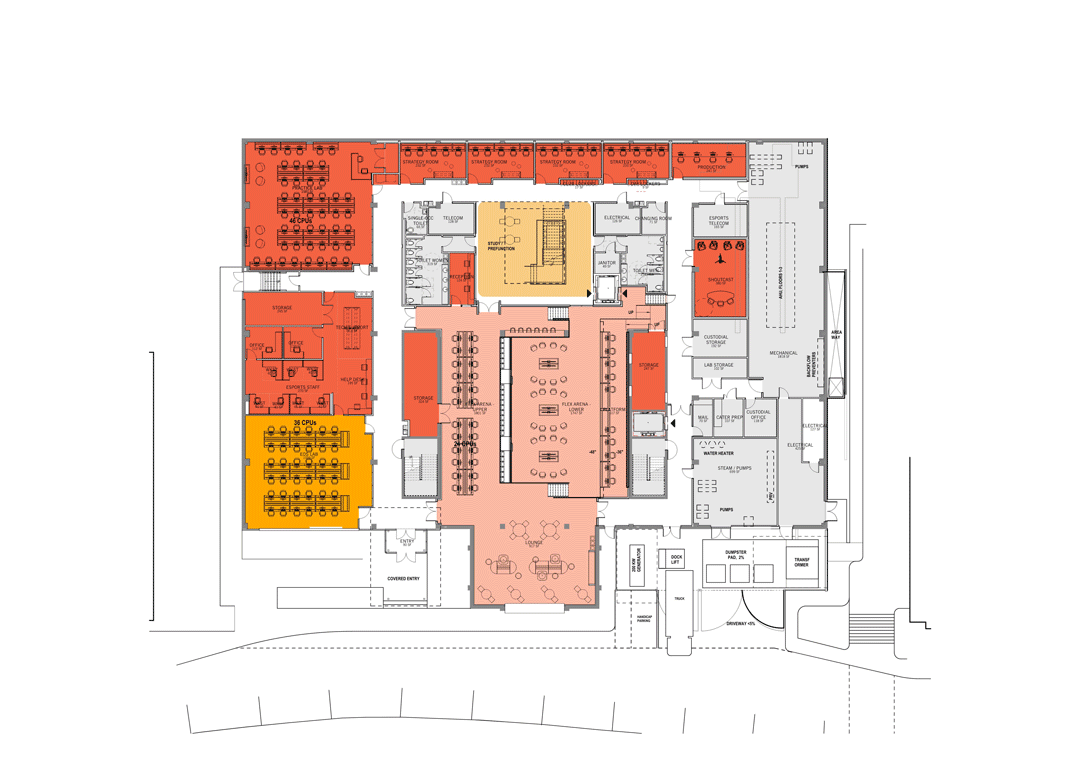




.jpg)




















